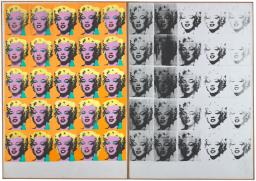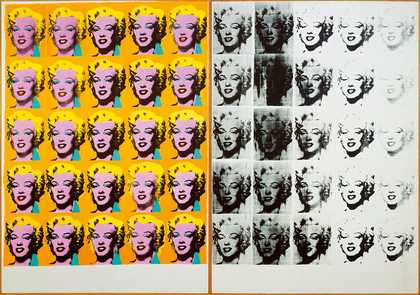12 rooms in In the Studio
Take a fresh look at WarholŌĆÖs Marilyn Diptych, newly restored by ░š▓╣│┘▒ŌĆÖs conservation team
In August 1962, Andy Warhol started experimenting with screenprints in his New York studio. When the actor Marilyn Monroe died the same month, Warhol was shocked by her death. He found a publicity photo of Monroe from the 1953 film Niagara, taken by the photographer Gene Kornman. Cropping her face, Warhol made a series of graphic screenprints based on the portrait. He painted over some of them by hand, then reprinted MonroeŌĆÖs face on top of the colour.
Originally two separate pieces, Marilyn Diptych was first purchased by art collectors Burton and Emily Tremaine. Emily later recalled their visit to WarholŌĆÖs studio: ŌĆśHe first showed us the black MARILYNS, and several pictures later the coloured one appeared. I said I thought they should be presented as a diptych, Andy replied ŌĆ£gee whiz yesŌĆØŌĆÖ. Together, the mask-like depictions of Monroe could hint at the experiences of a life led inside and outside the celebrity spotlight.
For the past two years, Marilyn Diptych has been carefully restored in ░š▓╣│┘▒ŌĆÖs painting conservation studio. Conservators worked to remove 60 years of dust and dirt using new imaging and cleaning technologies. The artwork now appears closer to how Warhol and the Tremaines would have seen it in 1962.
Funding for the conservation of this artwork was generously provided through a grant from the Bank of America Art Conservation Project.
Art in this room


